Basic Guidelines for Understanding the Landscape of the Hands:
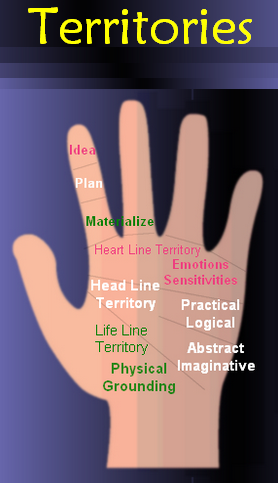
Traditionally the palm has been divided into three horizontal worlds or zones.
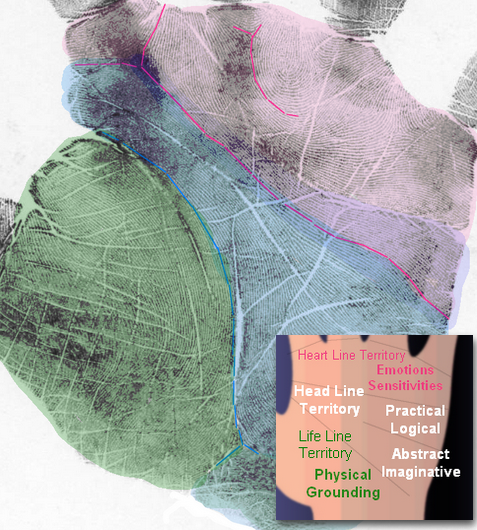 Notice how the fields in the palm above are similar to the fields formed by tracing the main lines from the dermatoglyphic triradii in the graphic here to the left. There are a range of variances in individuals in these fields just as there are variances in how the major creases flow in the palms from individual to individual, yet still have their familiar territories.
Notice how the fields in the palm above are similar to the fields formed by tracing the main lines from the dermatoglyphic triradii in the graphic here to the left. There are a range of variances in individuals in these fields just as there are variances in how the major creases flow in the palms from individual to individual, yet still have their familiar territories.
In primates the dermatoglyphic main lines and the major creases are often the same whereas in humans they are separate.
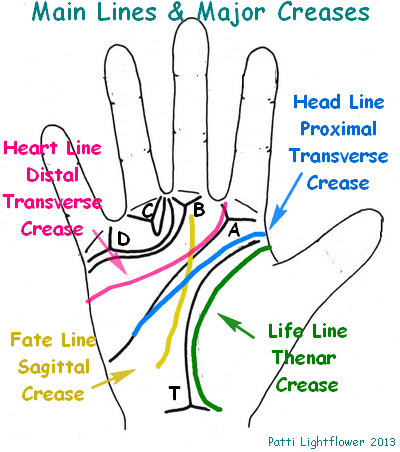
The zone closest to the fingers is generally considered as the area from where the fingers connect to the palm, down to the heart line and under the index finger. This area usually covers the mounts below the fingers. Typically the heart line (distal transverse crease) is located beneath the metacarpo-phalangeal joints. When you trace the radiant (main line A) from the a triradius you will find it usually ends at the percussion side of the hand ranging from close to the heart line to down into the palm. (see examples below) Sometimes the heart line is set too high, too low, or misaligned and then it (or the head line) might find itself out of its territory. William G. Benham in “The Laws of Scientific Hand Reading” offered that a crease out of its territory is not equipped with the tools it needs to function properly in the location it has found itself. This zone (that I’ve shaded in pink) relates to how we experience and express our emotions, feelings and respond to sensations.

Practical and creative thinking abilities are interpreted from features that are found in the middle zone. In most palmistry books you will find this middle zone as another section that might divide the palm into three nearly equal worlds in perfect horizontal fashion. In development the head line (proximal transverse crease) has more freedom in it’s location than the heart line or the life line (thenar crease). The start of it is strongly influenced by the index finger’s metacarpo-phalangeal joint, but after that it’s free to flow across the palm or to curve down into the palm. Since the head line can reach down into the lower ulnar corner of the palm this middle zone has been extended to follow this potential path. This field spans the space between the T main line (from t triradius and the A main line (from the a triradius) The location of the t Triradius (triradius typically located toward the wrist) can influence this field and create an additional field below if it is found high above the wrist. How we process our thoughts is represented by the features in this central and somewhat diagonal field.
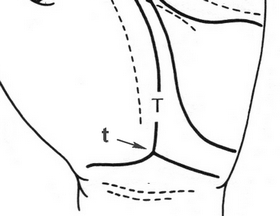
The lower zone of the hand has been associated with the physical energies and referred to as the instinctive zone or as part of the subconscious world. Here it is bound by the dermatoglyphic radiant from the t Triradius and is basically the full area inside the life line. Like the other zones this area can extend outside beyond the main crease with the range of its field. This outside area of this field extends toward the percussion and is often bound by the fate line (sagittal crease) and sometimes a downward bending head line. A large part of this area is the base of the thumb inside the structure of the palm. This represents the potential physical manifestations of the qualities of the thumb and at the same time our level of inner resources in reserve. Our physical energy and vitality is associated with the fullness of the thenar mount (Venus Mount). It is representative of our inner well of resources along with our urges and drives.
![]()
Previous methods of dividing the hand into three worlds relate to first a horizontal division at the fingers (which for some systems of division includes the mounts below the fingers). The next section is marked off at about mid-palm at the inside of the thumb and horizontally across. Typically crossing through the areas on both sides of the palm that in palmistry are called the upper and lower, or positive and negative, Mars mounts. The bottom section which pretty much includes the ‘heel’ of the palm as it rises from the central part of the palm and back down to the first wrist crease. This form of dividing the hand into horizontal planes (as opposed to following dermatoglyphic fields) is better described by looking at the hand and its energy in a spectrum in the length from fingertips (distal) to wrist (proximal) as described below.
![]()
The fingers and thumbs have their own zones easily detected by the interphalangeal creases that separate them and can be viewed as part of the entire hand or separately from the palm. The hand, the palm and the fingers each have these three zones. The thumb’s base zone is part of the palm known as the thenar mount. With the fingers we look at the tips as relating to receiving an idea, the middle section as to how the idea is planned and the base section is about the actuation and materialization. You get an idea, you plan it out and then you make it happen. Manifesting the idea into a reality or into something tangible, physical, and concrete is what this lowest section is about. In reverse we can see it as taking something we’ve made tangible and planning how to present it out into the world.
Three examples illustrating variances in the dermatoglyphic fields.
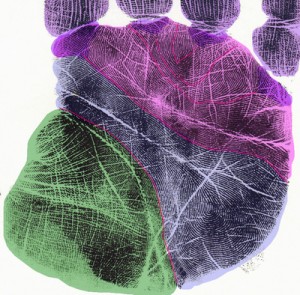
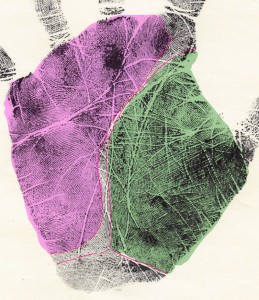

A vertical division separates the radial and the ulnar sides of the hand.
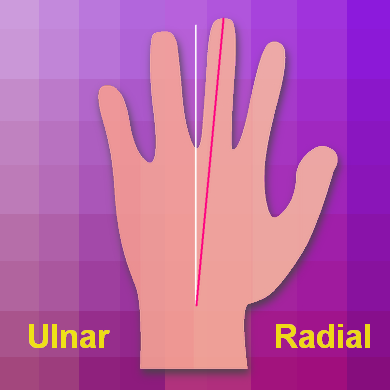
There are two major arteries and nerves that enter the palm. These are called Ulnar and Radial. The long bones in the arm are called the ulna and radius bones. The thumb side of the hand is known as the radial side and the little finger as ulna or ulnar.
The thumb side of the hand is stronger than the little finger side when it comes to gripping. The dominant hand is usually stronger than the non-dominant hand.
In the human hand, the thumb is capable of opposing all the other digits because of it’s position and its rotational ability. The little finger also is positioned in such a way that the hand folds to allow its pad to contact the pad of the thumb. This folding is mostly diagonal and follows the sagittal plane or the central part of the fate line up towards the middle finger. This mid-palm section of the fate line (sagittal crease) is typically firmly attached in the layers of the skin much like the other major creases.
The purpose of this deeper attachment is mostly for grip and keeping the skin from sliding around when holding onto something. We have two creases (sagittal and thenar) that are vertically attached and two horizontally attached creases (distal and proximal transverse). These creases are more commonly known as the fate, life, heart, and head lines and seen as the major and more important creases in hand analysis.
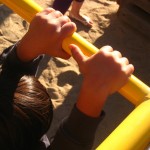
The Radial side of the hand relates mostly to the outer world and how we present ourselves and interact with our family, friends, general public, and our environment. The Ulnar side of the hand is more associated with how we process what we have received from the outer world via our senses and our experiences. The entire hand represents how we express our inner self out into the world. Yet, as we move from the thumb to the little finger (percussion) side of the hand, we move from what we are more willing and able to expose of ourselves to what we are more careful to hide.
The dominant hand would be the most conscious and public representation and the non-dominant hand shows what we most prefer to keep hidden and may not even be consciously aware of ourselves. A spectrum in each hand ranging from outer self to inner self, with one side more private than the other, is found in the radial to ulnar sides of the hands.
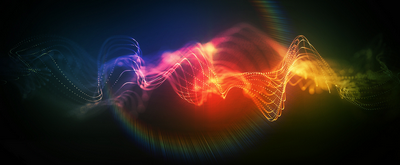
There are two common placements for making this vertical division. One way is to divide the hand from the center of the wrist up to the tip of the middle finger, dividing the middle finger into two sections. The other method involves dividing the hand between the middle and ring fingers. If you can view the energy as ranging in polarity from the radial to the ulnar side then this area in the middle is basically the same regardless of whether you divide the middle finger or move it to the radial side entirely. Because the sagittal crease typically aims toward the middle of this finger, making a division here can make sense, but it’s probably more a personal preference to the hand analyst using a quadrant system.
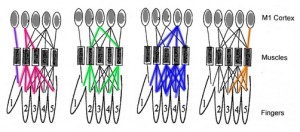
This middle section, including the whole middle finger, can also be seen as allowing for three worlds vertically. However, there is no definite point where the energy shifts from outer to inner. There is instead a slow blending from one to the other with a sort of neutral or balanced zone in the middle.
Spanning from the tips of the fingers down to the wrist is a lengthwise field of changing energies.
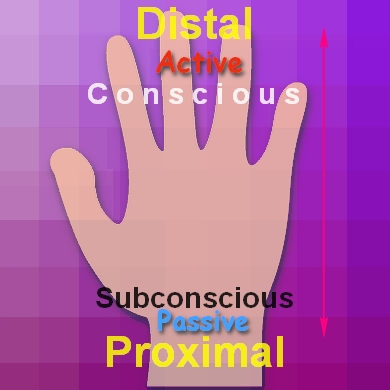 Looking at the hand from fingertips to the wrist we can visualize the energy as flowing both directions. When we touch something the sensory cells send signals describing what we have touched such as its texture, temperature and vibration. Our fingertips have more nerve endings than any other part of the hand and the index fingertip pad has the most of all. Reaching out to touch our loved ones, loving energy flows outward from our hands and we feel in return their loving vibrations. Everything we do with our hands involves this two way flow of energy.
Looking at the hand from fingertips to the wrist we can visualize the energy as flowing both directions. When we touch something the sensory cells send signals describing what we have touched such as its texture, temperature and vibration. Our fingertips have more nerve endings than any other part of the hand and the index fingertip pad has the most of all. Reaching out to touch our loved ones, loving energy flows outward from our hands and we feel in return their loving vibrations. Everything we do with our hands involves this two way flow of energy.
We should view this energy in the same spectrum field we looked at in the radial to ulnar directions. Whereas the energy shifted in polarity from thumb to little finger side in degrees of openness and privacy, the polarity from fingertips to wrist is relating to making ideas a reality. A spectrum here ranges from ethereal, airy thoughts to tangible, earthy grounding. The fingers are appendages that extend out from the body as feelers and antennas. In palmistry this area is seen as the Conscious or Active Zone. We hold the world in the palms of our hands, but it is with the fingers that we interact with and change the things we touch.
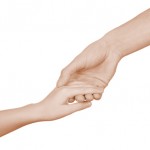 As we move into the palms, there is less movement than the fingers, but still the hand is flexible and bendable across the top of the palm. This area is basically the area above and including the heart line. Here we start the process of reacting and interacting with our environment and who and what is in it. This area relates to sensations, feelings and emotions. We are still in the conscious and active zone but we must keep in mind to some degree the range of public to private in the span from the radial to ulnar sides. In this territory we compare the incoming data to former experiences that are recorded as visual and emotional memories. Markings that form here show how we make contact with others and with our environment. Across this area we see features that reveal our ambitions, our desire to communicate, to love, learn, develop our skills and talents, and our ability to have empathy and show mercy. This being a more conscious zone, the reasons we are moved to do these things are closer to the surface of our awareness.
As we move into the palms, there is less movement than the fingers, but still the hand is flexible and bendable across the top of the palm. This area is basically the area above and including the heart line. Here we start the process of reacting and interacting with our environment and who and what is in it. This area relates to sensations, feelings and emotions. We are still in the conscious and active zone but we must keep in mind to some degree the range of public to private in the span from the radial to ulnar sides. In this territory we compare the incoming data to former experiences that are recorded as visual and emotional memories. Markings that form here show how we make contact with others and with our environment. Across this area we see features that reveal our ambitions, our desire to communicate, to love, learn, develop our skills and talents, and our ability to have empathy and show mercy. This being a more conscious zone, the reasons we are moved to do these things are closer to the surface of our awareness.
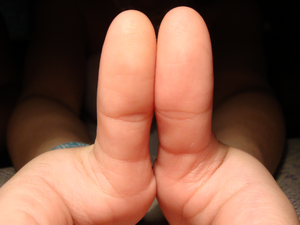
The thumb is located on the radial side of the hand and is related to the outer world. The base of the thumb is located in the palm as the thenar mount. As such the base is in the lowest part of the range from fingertips to wrist, and the thumb tip is found in the active zone when it is held close to the palm. The phalanges of the thumb will be described in more depth in the section about the digits.
Here it is important to note that the thumb bridges several worlds and is the only digit to simultaneously be in both the Active Conscious and the Passive Subconscious Zone.
Down below the heart line we move past the area of emotions and into the area of thinking and reasoning. This is the territory of the head line or proximal transverse crease. Moving away from the realm of feelings and sensations, this next area relates to how we initiate thinking, and from there how we proceed through the processing into the results or completion of an idea or mental endeavor. Features here show if we are quick thinkers who are able think on our feet or do we like to take our time, sleep on an idea, and be more detailed and thorough.
The amount of space between the heart and head lines gives important clues as to how open or closed a person can be and the strength of their preferences. This horizontal span of space that bridges the territories of the emotions with the physical is framed on each side by the two mounts that are most commonly referred to in palmistry as ruled by Mars. The central zone between these two mounts is called the Plain of Mars. This central zone is also known as the hollow of the palm. Our strengths, initiative, stamina and general well being can be determined in the qualities of these features situated in the middle horizontal span of the palm.
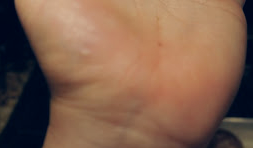 Above the wrist the palm rises in usually a firm ridge that is often referred to as the heel or base of the palm. The radial side contains the thenar mount, or thumb’s base, and the ulnar side contains the hypothenar. The carpal bones lie underneath this bulging area. This lowest part of the palm is representative of our our core foundation, our ancestral roots and the connection to our body. It relates to the zones known as the collective unconscious or subconscious. From the hypothenar area intuitive and insightful thoughts rise to our consciousness giving us warnings, connecting the dots, and advance clues on our path. Surfacing from our thenar area comes our primal instincts, cravings, desires and urges; all helping to provide us with the motivation required to move forward.
Above the wrist the palm rises in usually a firm ridge that is often referred to as the heel or base of the palm. The radial side contains the thenar mount, or thumb’s base, and the ulnar side contains the hypothenar. The carpal bones lie underneath this bulging area. This lowest part of the palm is representative of our our core foundation, our ancestral roots and the connection to our body. It relates to the zones known as the collective unconscious or subconscious. From the hypothenar area intuitive and insightful thoughts rise to our consciousness giving us warnings, connecting the dots, and advance clues on our path. Surfacing from our thenar area comes our primal instincts, cravings, desires and urges; all helping to provide us with the motivation required to move forward.
As has been described with the fingers, the energy of the palms and our whole hands can be seen as flowing in both directions, in and out, like our breath and heartbeat. The fingers are illustrative of how we express and interact with the world and the palm is more about the internalizing of the world and our selves. The whole hand then shows the entire movement of energy coming in and being processed. In reverse, our impulses and desires come from deep within and rise to the surface to be manufactured in our minds and then into reality and expressed out into the world.
Combining the vertical and horizontal fields creates the quadrants.
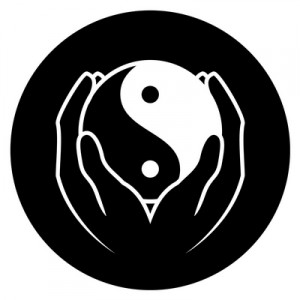
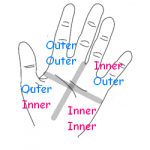 Seeing and understanding the relationship and the balance in what appears to be opposites and polarities is perhaps the most difficult to comprehend and put into practice for the beginning hand analyst. The symbol for yin and yang illustrates how inside of each half is a place, at the core, containing a part of its complementary energy. In dividing the hands we can see that the top part of the hand is active, which is yang energy and the bottom is passive and which is yin. The radial side of the hand in its outer world orientation is yang and the ulnar side is an expression of yin in that it is receptive and inner world oriented.
Seeing and understanding the relationship and the balance in what appears to be opposites and polarities is perhaps the most difficult to comprehend and put into practice for the beginning hand analyst. The symbol for yin and yang illustrates how inside of each half is a place, at the core, containing a part of its complementary energy. In dividing the hands we can see that the top part of the hand is active, which is yang energy and the bottom is passive and which is yin. The radial side of the hand in its outer world orientation is yang and the ulnar side is an expression of yin in that it is receptive and inner world oriented.
What is probably the first and most important aspect to be explained is nomenclature. What is meant by the terms: inner-outer, active-passive, yin-yang, and in what dictionary resources or esoteric studies are the chosen definitions found? This is a very important question. There are many answers with some being contradictory and some are just seemingly contradictory. Going in search of these answers can lead you down many paths leading to self insight, both biologically and spiritually. Follow what rings true inside of yourself, what gives you ah-ha moments and feels familiar like home.
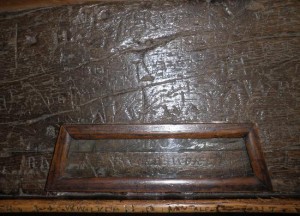
Our outer self relates to how we present our selves to the world. How we would like to be seen by others. It’s our personality that shows through, to the outside from within, that individualizes us. It includes the persona, the mask with which we cover and hide our vulnerabilities. It relates to how we want to leave an impact in some way on our environment, our world. To say I was here. In one of it’s simplest forms, imagine an old school desk you have sat in at some time and could see, through the sanding and varnish, the many names, doodles, initials and hearts that were etched into the wood. Maybe when no one was looking you added your own impression. Through our outer self we connect socially and explore the world around and outside of us.
Our inner self is more personal and private. Here is where we can hide or another place where we can explore or just look within. We don’t want people to read our minds, although our body language reveals our inner workings like an open book. We allow people into our personal spaces by special invitation. We have our private thoughts, our letters, journals, (that we’d burn before we’d make public on our blog) our memories, and our dreams. This inner world is a limitless inner space for self understanding and spiritual awareness. Inspiration, insight and creative visions are born here.
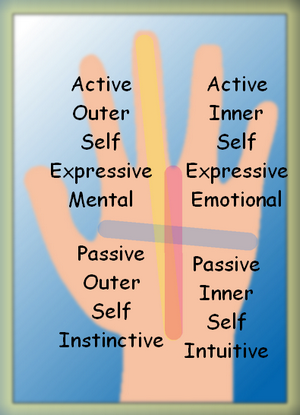 Active relates to something that is energetic and a moving force. We are electrical beings with both positive and negative charges. In the hands, the active areas include the fingers, thumbs, and the mounts immediately under the fingers. These are the most flexible, movable parts of the hands. Active energy is similar to outer energy in that it has the sense of something that is moving outwards or expanding. We reach out and taste our world with our sense of touch.
Active relates to something that is energetic and a moving force. We are electrical beings with both positive and negative charges. In the hands, the active areas include the fingers, thumbs, and the mounts immediately under the fingers. These are the most flexible, movable parts of the hands. Active energy is similar to outer energy in that it has the sense of something that is moving outwards or expanding. We reach out and taste our world with our sense of touch.
Passive is an interesting term. It suggests a lack of interest or feelings of lethargy. It’s not my favorite choice as a label for the bottom of the hand. The active top part of the hand relates to being responsive and reactive to the environment, whereas the bottom of the hand is more about the kind of behavior that comes from urges and drives. Passive is not having a reaction to an outer force, leaving room for an action that rises from within seemingly uninfluenced by others. In combining the essences in the hands, Passive-Outer is similar to being proactive, as opposed to reactive, which is more comparable to Active-Outer.
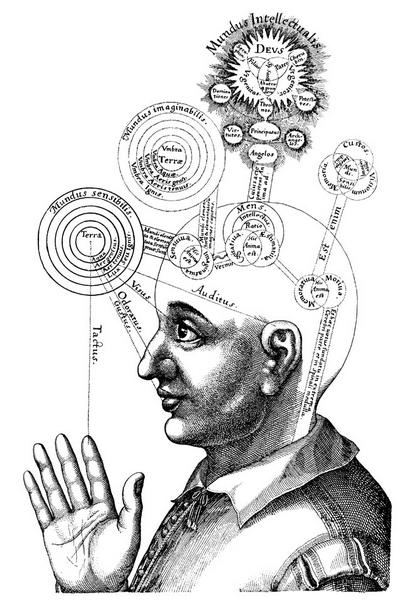 Another way to look at these polarities is objective and subjective. Objective here relates to making decisions that are not influenced on personal feelings and viewpoints. It would seem nearly impossible to not have some kind of personal feelings or reaction to what we are observing. We experience everything through our own perceptions and level of experience and understanding. The digits would be the most objective part of our hands as they relate to the active area. They sense the environment directly. Once the signals move to the zones where emotional memories are stored the input is tainted and tinted with those impressions. Continuing down the palm, the degree of objectivity vanishes into subjectivity as we subconsciously compare the input to our own baggage and wisdom.
Another way to look at these polarities is objective and subjective. Objective here relates to making decisions that are not influenced on personal feelings and viewpoints. It would seem nearly impossible to not have some kind of personal feelings or reaction to what we are observing. We experience everything through our own perceptions and level of experience and understanding. The digits would be the most objective part of our hands as they relate to the active area. They sense the environment directly. Once the signals move to the zones where emotional memories are stored the input is tainted and tinted with those impressions. Continuing down the palm, the degree of objectivity vanishes into subjectivity as we subconsciously compare the input to our own baggage and wisdom.
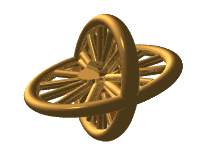
As always I welcome your related feedback & questions in the reply box below!
in joy and peace,
Patti Lightflower

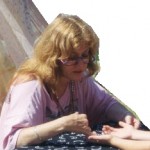
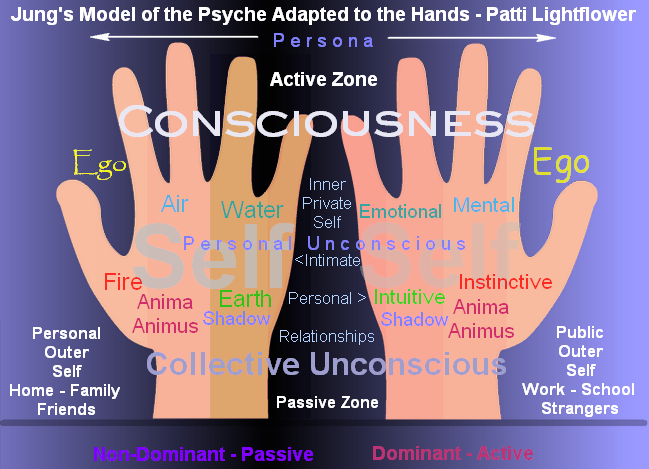
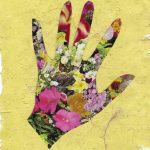
Patti
Very well written article, neatly explained about passive active dominant inner self ect.. I might have some questions later.
Anand
Hi patti
I was reading through again and thinking where in you have mentioned about active and passive, sometimes in life we go through what is called as gut feeling or intuitive feeling and sometimes through rationalization, experiences, memory ect.. How would you say which area dominates.
Like for example some people have wide spread gap between mecrcury and appollo finger does that indicate the passive inner self dominates. or having mercury lines indicate.
Like more lines in these area would indicate domination.
Anand
Regarding gut versus intuition, I would look at the Health or Mercury Line. If it rises from the radial side of the hand I would see the person making decisions based on instinct, gut, or physical inner reactions. If it instead curves to come from the ulnar side of the hand in the hypothenar area then it would relate to intuition, insight and abstract thinking. The condition of the head line and how it interacts with this crease would give me some idea of how this energy is tapped into and used.
I don’t know what you are asking in regards to the little and ring fingers, gap, dominance…? Sounds like something you’d have to consider in regards to combining the features in front of you.
Regarding the gap between mercury and Apollo finger I was wondering whether is it an indicator that intuitive parts dominates. It is like mentioning the mercury finger has more freedom which probably arises due to the dominance of hypothenar, and other mounts in subconscious zone.
Anand